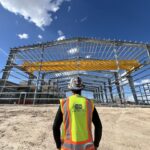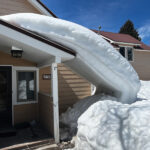
Concealed fasteners do an outstanding job holding metal panels in place
Whether driving through small towns, suburbs or major cities, metal roofing is showing up everywhere. What was once utilitarian has become quite fashionable. For more than a century, metal was found only on farmhouses, barns and industrial buildings; now it is showing up on larger, more contemporary structures of all types.
 This once rural roof covering has made its way onto our schools, libraries and high-end commercial buildings. It is now considered an upgrade for homes in “design-control” communities. Metal roofing is not new to the market; metal corrugated roofs have been around for decades. Today, modern applications utilize high-tech materials in colors and patterns almost as limitless as our imagination. There is no question that seeing these attractive, well-tailored designs can be very enticing to the potential homebuilder or remodeler. Before investing your hard-earned dollars in one of these colorful new roofs, there are a few things you need to consider.
This once rural roof covering has made its way onto our schools, libraries and high-end commercial buildings. It is now considered an upgrade for homes in “design-control” communities. Metal roofing is not new to the market; metal corrugated roofs have been around for decades. Today, modern applications utilize high-tech materials in colors and patterns almost as limitless as our imagination. There is no question that seeing these attractive, well-tailored designs can be very enticing to the potential homebuilder or remodeler. Before investing your hard-earned dollars in one of these colorful new roofs, there are a few things you need to consider.
You first need a clear understanding of your wishes, wants and requirements, and how the systems are similar as well as how they differ. Many of us picture that “Americana” house, with snow on the roof and smoke coming from the chimney and want our home to be just like that: beautiful, warm and trouble free. But there are a few realities beyond the visual beauty that need to be considered.
Exposed fasteners
Exposed fastener roof systems are what most of us are familiar with: rolled metal panels nailed or screwed to rafters, roof decking or installed over existing roof systems. Since the panels come in a wide variety of colors and the exposed fasteners are painted to match the roof panels, this can be a very attractive and affordable system. These light-gauge, screw-down systems will fit most budgets because they are economical, and quick and easy to install. But there are shortcomings of which you need to be aware.
As the installation settles and ages, theweather changes from season to season and in some cases, from day to night, causing changes in temperature and humidity. Materials will expand and contract. When the screws are fastened through the panel there is no room for this expansion and contraction to work itself out. Although panels move very little, the force is sufficient to cause one of several possible scenarios: The fastener can loosen.
The fastener can break or the hole can become elongated causing leaks that could result in costly repairs. This could take years to develop, or depending on installation conditions may never happen at all, but it is a possibility for this type of installation.
Concealed fasteners
Systems developed to overcome these scenarios are referred to as standing seam panels or concealed fastener systems. As the names imply, there are concealed fasteners holding clips to the structure that mechanically engage with interlocking rib seams to hold the panels in place. While quite a bit more expensive to install, the standing seam system addresses shortcomings of the traditional roof system. There are none of the penetrations caused by drilling screws through the panels to hold them in place. Standing seam is usually designed with a slotted strip in the panel or a clip system attached to the roof. The panels are then attached to the clips. All fasteners are below the panel instead of installed through the panels. No holes or penetrations in the panels mean leaks should be virtually non-existent assuming proper installation.
Before making your decision, ask the contractor to go over the details.
• Pros and cons
• What are the options?
• Which fastening system do they use to install most often and why?
• Explain the cost differences
• What do they recommend?
• What gauge material?
• Warranties
• What to expect if a leak ever develops
The end result is only going to be as good as the materials and the installing contractor. Cutting corners on the details can make for costly repairs in the future. Properly installed with quality materials, a metal roof should be the last roof you will ever need.
Keith Self is product manager at Birmingham Fastener, Birmingham, Ala. To learn more, visit www.bhamfast.com or reach him at keith.self@bhamfast.com.






